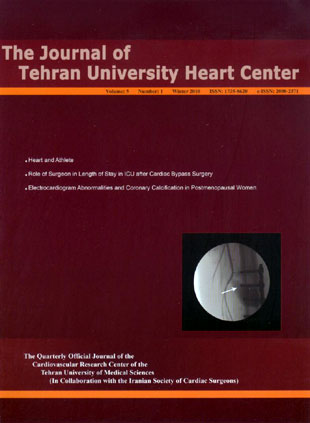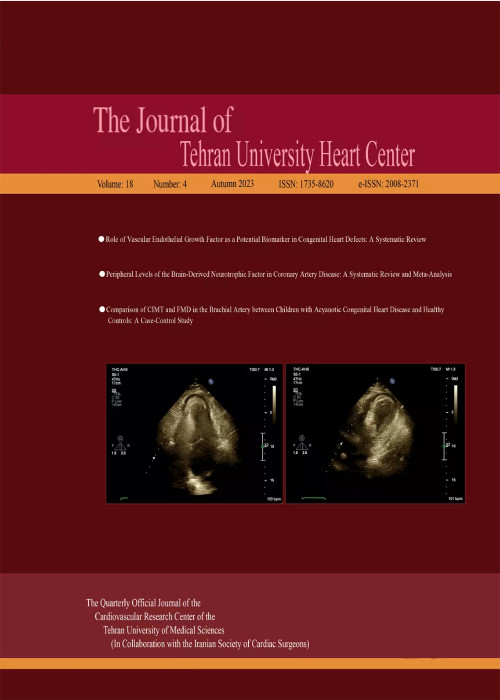فهرست مطالب

The Journal of Tehran University Heart Center
Volume:5 Issue: 1, Jan 2010
- تاریخ انتشار: 1388/11/11
- تعداد عناوین: 9
-
-
Page 1Regular participation in intensive physical exercise is associated with electro-morphological changes in the heart. This benign process is called athlete’s heart. Athlete’s heart resembles few pathologic conditions in some aspects. So differentiation of these conditions is very important which otherwise may lead to a catastrophic event such as sudden death. The most common causes of sudden death in young athletes are cardiomyopathies, congenital coronary anomalies, and ion channelopathies. The appropriate screening strategy to prevent sudden cardiac death in athletes remains a challenging issue. The purpose of this review is to describe the characteristics of athlete’s heart and demonstrate how to differentiate it from pathologic conditions that can cause sudden death.
-
Pages 9-13BackgroundWe presumed that the surgeon himself has an impact on the results after coronary artery bypass grafting (CABG) as there is no unique protocol for the discharge of post-operative cardiac patients at our institution. Therefore, we examined whether the surgeon himself has an impact on the intensive care unit (ICU) stay of isolated CABG patients.MethodsWe prospectively studied a total of 570 consecutive patients undergoing elective CABG. Length of stay in the ICU was defined as the number of days in the ICU unit post-operatively. Seven operating surgeons were classified in 3 categories on the basis of the mean hospital stay of their patients (1, 2 and 3 if the mean total patients'' stay in hospital was <8 days, between 8 to 10 days, and longer than 10 days; respectively). Using a multivariable regression model, we determined the independent predictors of length of stay in the ICU (> 48 hours) and examined the role of surgeon in this regard.ResultsIncidence of post-operative arrhythmia and length of ICU stay were higher in the patients of surgeon category 3 than those of surgeon categories 1 and 2. Surgeon category 3 also operated on patients with higher EuroSCOREs than did surgeon categories 1 and 2. With the aid of a multivariable stepwise analysis, three variables were identified as independent predictors significantly associated with ICU length of stay: age, history of cerebrovascular accident, and surgeon category.ConclusionSurgeon category may independently predict a prolonged length of stay in the ICU. We suggest that a unique discharge protocol for post-CABG patients be considered to restrict the role of surgeon in the ICU stay of these patients.
-
Pages 14-18BackgroundCardiac involvement in systemic sclerosis (SSc) is more prevalent than previously thought. In this study, the frequency and severity of cardiovascular involvement were assessed in SSc patients referred to Firouzgar Hospital.MethodsFifty-eight patients with SSc, selected from the data bank of SSc patients, were reviewed for the frequency and severity of 8 organ involvements in this case series.The preliminary severity scale, published by international SSc study groups, was employed for the determination of the severity grade in the cardiovascular system. In the cardiac scoring scale, grade 0 represents normal heart (no cardiac involvement), grade 1 denotes mild involvement [electrocardiography (ECG) conduction defect and a left ventricular ejection fraction (LVEF) of 45-49%)], grade 2 signifies moderate involvement (arrhythmia, LVEF = 40-44%), grade 3 indicates severe involvement (LVEF <40%)], and grade 4 stands for end stage (congestive heart failure and arrhythmia requiring treatment).ResultsIn this study, 24 (41.4%) patients were in the diffuse cutaneous (dcSSc) subset. The female to male ratio was 10.5:1, and the mean duration from symptom onset to diagnosis was 7.35 years for the dcSSc subset and 8.41 years for the limited cutaneous (lcSSc) subset of disease, there being no significant difference. Cardiac involvement in this series was seen in 13 (22.4%) cases, and there was no significant difference in terms of frequency and severity between the two disease subgroups (p value = 0.96 and p value = 0.46 respectively).ConclusionOur findings showed that the cardiac involvement in this series was infrequent and that there was no significant difference in the severity of cardiovascular involvement between the two subtypes of SSc in the late stage of the disease.
-
Pages 19-24BackgroundAn electrocardiogram (ECG) can provide information on subclinical myocardial damage. The presence, and more importantly, the quantity of coronary artery calcification (CAC), relates well with the overall severity of the atherosclerotic process. A strong relation has been demonstrated between coronary calcium burden and the incidence of myocardial infarction, a relation independent of age. The aim of this study was to assess the relation of left ventricular hypertrophy (LVH) and ECG abnormalities with CAC.MethodsThe study population comprised 566 postmenopausal women selected from a population-based cohort study. Information on LVH and repolarization abnormalities (T-axis and QRS-T angle) was obtained using electrocardiography. Modular ECG Analysis System (MEANS) was used to assess ECG abnormalities. The women underwent a multi detector-row computed tomography (MDCT) scan (Philips Mx 8000 IDT 16) to assess CAC. The Agatston score was used to quantify CAC; scores greater than zero were considered as the presence of coronary calcium. Logistic regression was used to assess the relation of ECG abnormality with coronary calcification.ResultsLVH was found in 2.7% (n = 15) of the women. The prevalence of T-axis abnormality was 6% (n = 34), whereas 8.5% (n = 48) had a QRS-T angle abnormality. CAC was found in 62% of the women. Compared to women with a normal T-axis, women with borderline or abnormal T-axes were 3.8 fold more likely to have CAC (95% CI: 1.4-10.2). Similarly, compared to women with a normal QRS-T angle, in women with borderline or abnormal QRS-T angle, CAC was 2.0 fold more likely to be present (95% CI: 1.0-4.1).ConclusionAmong women with ECG abnormalities reflecting subclinical ischemia, CAC is commonly found and may in part explain the increased coronary heart disease risk associated with these ECG abnormalities.
-
Pages 25-28BackgroundWe sought to evaluate the routine echo-Doppler screening of carotid artery stenosis in patients undergoing coronary artery bypass grafting.MethodsA total of 2179 consecutive patients who underwent coronary artery bypass grafting alone or with other cardiac surgery at Tehran Heart Center, Tehran-Iran, between January 2005 and January 2006 were included in this retrospective study. Carotid Doppler was performed for 1604 (81.48%) of these patients.ResultsThe patients’ age ranged between 20 and 84 years (mean: 58.33, SD: 10.08 years). Of the 1604 patients studied, 1186 (73.9%) were men, 592 (36.9%) had diabetes, 598 (37.3%) were smokers, and 194 (12.1%) cases had significant left main stenosis. Twenty-one (1.3%) patients had significant carotid stenosis (> 60% stenosis), which constituted 0.9% of all the bypass surgery candidates. Post-operative cerebrovascular accident was not detected in any of the patients with significant carotid stenosis, but cerebrovascular accident occurred in 22 (1.4%) of the patients without carotid stenosis. Magnetic resonance angiography (MRA) was conducted in 15 patients. In our univariate analysis, female gender (p value = 0.023), hypertension (p value = 0.055), peripheral vascular disease (p value < 0.001), and age (p value = 0.001) were significant in the development of carotid stenosis.ConclusionPre-operative duplex carotid screening seems to be necessary in patients when there is hypertension, peripheral vascular disease, female gender, and advanced age
-
Pages 29-35BackgroundMore diagnostic techniques require a better understanding of the forces and stresses developed in the wall of the left ventricle. The aim of this study was to differentiate significant coronary artery disease (CAD) patients using a non-invasive quantification of myocardial wall stress in the diastole phase.MethodsSixty male subjects with sinus rhythm (30 patients with significant and 30 with moderate left anterior descending coronary artery stenosis in the proximal portion) as well as 35 healthy subjects as the control group were recruited into the present study. By two-dimensional, pulsed wave, and tissue Doppler echocardiography, the average end-diastolic wall stress was calculated at the left ventricle anterior and interventricular septum wall segments using regional wall thickness, meridional and circumferential radii, and non-invasive left ventricular end-diastolic pressure.ResultsA comparison of the calculated end-diastolic myocardial wall stress between the patients with significant and moderate coronary stenosis on the one hand and the healthy subjects on the other showed statistically significant differences in the anterior and septum wall segments (p value < 0.05). The patients with significant left anterior descending coronary artery stenosis had higher end-diastolic myocardial wall stress than did those with moderate stenosis and the healthy group in all the anterior and septum wall segments.ConclusionIt is concluded that non-invasive end-diastolic myocardial wall stress in coronary artery disease patients is an important index in evaluating myocardial performance
-
Pages 36-38Left ventricular free wall rupture is responsible for up to 10% of in-hospital deaths following myocardial infarction. It is mainly associated with posterolateral myocardial infarction, and its antemortem diagnosis is rarely made. One of the medical complications of myocardial infarction is the rupture of the free wall, which occurs more frequently in the anterolateral wall in hypertensives, women, and those with relatively large transmural myocardial infarction usually 1-4 days after myocardial infarction.We herein present the case of a 66-year-old man suffering inferior wall myocardial infarction with abrupt hemodynamic decompensation 9 days after myocardial infarction. Emergent transthoracic echocardiography revealed massive pericardial effusion with tamponade, containing a large elongated mass measuring 1 × 8cm suggestive of hematoma secondary to cardiac rupture. In urgent cardiac surgery, the posterior wall between the left coronary artery branches was ruptured.
-
Pages 39-41A 4-month-old boy was admitted to our hospital following an unsuccessful attempt at interventional repair of aortic coarctation via the right carotid artery, which seemed to have given rise to the formation and growth of a cervical mass overlying the entry site. Despite the initial anticipation of difficulty during intubation due to the pressure effect of the mass, anesthesia progressed uneventfully, the mass, which was a hematoma, was evacuated, and the coarctation was repaired. The patient was discharged after the operation. At three weeks’ follow-up, there was no significant lesion in the neck and transthoracic echocardiography demonstrated no residual coarctation.
-
Pages 42-44Vascular injuries with acute or chronic arterial hemorrhage after femoral shaft fractures are a rare but a life-threatening complication. We observed a case of iatrogenic rupture of the profunda femoris artery after the internal fixation of a femoral shaft fracture. The pseudoaneurysm, presenting with painful expansile swelling and hemodynamic instability, together with the rupture was evident on femoral angiography. Endovascular stent graft placement was performed successfully, and there was no sign or symptom at 9 months’ follow-up.


